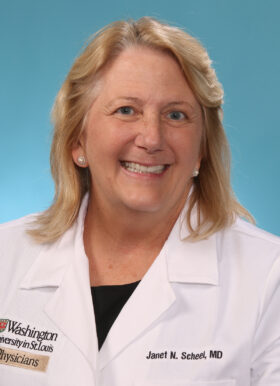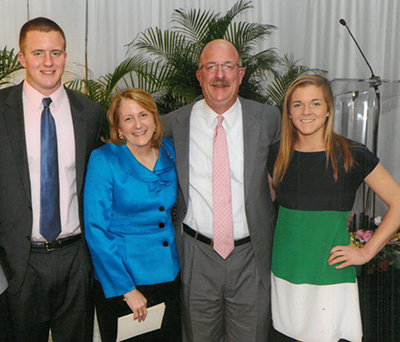Janet Scheel, MD

Janet Scheel, MD. is a pediatric cardiologist. Her areas of interest include pediatric heart transplantation, heart failure, fetal echocardiography and heart disease in children.
Dr. Scheel sees patients at:
- St. Louis Children’s Hospital, 1 Children’s Place, St. Louis, MO 63110
- St. Louis Children’s Specialty Care Center, 13001 North Outer Forty, Suite 2E, St. Louis, MO 63017
Please call 314-454-6095 for an appointment.
What happened in the course of schooling to influence you to choose your specialty?
I am a pediatric cardiologist and specialize in pediatric heart failure and heart transplantation.
During my third and final year of residency at Johns Hopkins, I spent time in the cardiac catheterization lab with one of the cardiology attending physicians. She was actually the first doctor to perform a balloon dilatation of a pulmonary valve (or of any valve). I found that I really enjoyed being in the cardiac catheterization lab and doing those interventions. It was also during that training at Johns Hopkins that I gained experience, and subsequently fell in love with the field of pediatric heart transplantation. It is a fascinating, always changing field.
What brought you to Washington University?
I was medical director of a heart failure/transplant program at Children’s National Medical Center in Washington, D.C., when my husband was recruited by Washington University. We’ve been to this campus many times because our son attended medical school here and we were very impressed with it. Because of that, we decided to come take a look — and here we are.

Was it a difficult decision?
Yes and no. My husband had been at Johns Hopkins for 30 years. We lived in the same home for the past 25 years — our kids were raised there and we had lots of friends there. My mother-in-law still lives in Baltimore. While it was hard in some ways, in other ways it was so clear it was the right thing to do. It was a great opportunity for both of us.
St. Louis Children’s Hospital has been a leader in pediatric heart transplant for many years. The chance to be a part of the transplant program and the opportunity to work with the hospital’s transplant center director, Dr. Charlie Canter, were two factors that helped make this an easy decision. I am excited to be here.
Also, I’m very happy to be walking to work now — not commuting an hour and a half each way!
What is one of your biggest challenges as a pediatric transplant cardiologist?
One of the biggest challenges is a heart transplant is not really a cure – it just replaces one problem with another problem. But the quality of life we give our patients is so good – we only do a transplant when we have no other options. It is amazing to watch how well our patients do after a transplant – I just hope we can eventually find a way to make it last longer.
Do you follow your patients through adulthood?
Typically, depending on the circumstances, we follow them through their college years. Partly because it is easier for them to call a doctor they know and who knows them when they are away at school. As they get older, late twenties and early thirties, we transition them to adult programs.
It is pretty exciting that now our patients are doing well enough and we have to worry about transitioning to adult care, going to college, becoming parents and doing all those things we always hoped they would be able to do. It was not that long ago that our pediatric heart patients, unfortunately, did not live long enough to transition to adult care. It is a nice problem to have.
The best part of my job is that I get to see my young patients thrive after they have received their transplanted hearts – even though when they first came to me, they were at their sickest. I get to be there with them as them grow up, go to college and live their lives. That is pretty cool.
Do you talk to the donor families?
These families have made this incredible decision, giving the gift of life during the worst day of their lives when they are losing a child. We now know that talking to the donor families helps start the healing process – knowing something good has come out of this absolutely horrible day. And often they donate not just their loved one’s heart, but lungs, kidneys, liver, pancreas – so one patient can potentially help seven others. It is pretty incredible. We only talk with the families when and if they are ready.
What is the youngest age you can do a heart transplant?
Years ago, we could actually list a patient for a heart transplant in utero – if we knew the unborn baby had the kind of heart disease that couldn’t be helped with any surgical options. Once the mom was far enough along, if a donor became available, we would deliver the baby and perform the transplant.
Because our surgical techniques and operations have improved, we now usually have the opportunity to repair the heart before going straight to transplant – even in very young infants. For this reason, we no longer list anyone in utero for a transplant. So the youngest age now is a newborn.
Which aspect of your practice is most interesting?
The most interesting part is also the most challenging part — the immune system. When you transplant somebody’s heart, the body recognizes it as foreign, and just like an infection, the immune system works to reject that heart.
The whole challenge of transplant is preventing that rejection, but at the same time not immunosuppressing someone so much that he or she has infections and dies from other causes.
Because a patient with a heart transplant must stay on immunosuppressant drugs his or her entire life, we must balance the medication that patient needs with what can safely be given – in order to minimize the adverse side-effects of the drugs.
During my almost three decades of working in transplant, it is incredible how much we have learned about the immune system. What I love about medicine is learning something new all the time — yet every time I learn something, I feel like I know even less. That is really particularly true of transplant immunology.
What new developments in your field are you most excited about?
Besides advances in immunology, the developments in mechanical circulatory support are changing pediatric heart failure and pediatric heart transplant.
The left ventricular assisted devices (pumps) do the work of the heart while the patient is waiting for a donor. What is gradually happening is that some of these devices are lasting a long time. These devices are allowing us to keep children alive long enough to get hearts, where before that wasn’t the case and children would die waiting for a transplant or get too sick waiting to be considered a candidate for transplant.
At some point in the future, it is possible that these devices will last as long as a transplanted heart. It is exciting to see how these devices have developed and continue to develop – it is just incredible.
Are the devices getting smaller?
They are getting smaller for older patients, but right now the only devices for small patients are larger ones that sit outside the body. They pump like the heart does, but because they are outside the body, the children stay inside the hospital waiting for the transplant.
Older or bigger patients and adult patients are able to use “continuous flow devices”. These are completely implantable with just a drive line coming out of the skin that connects to a battery pack. One of my patients even went on Space Mountain (not with my permission!) with his device. I’m glad I didn’t know that until after – but it shows you these kids can do a lot while waiting for a transplant.
There is an NIH-sponsored clinical trial called PumpKIN (Pumps in Kids and Neonates) for a continuous flow device that is about the size of an AA battery.
The biggest challenge with these smaller devices is the forming of blood clots. Our hope is this smaller device will let us get our little ones home and have them wait there for their transplant – which would be awesome.
Where are you from originally?
I was born and raised in New Jersey. My parents made chocolate for a living — they owned Nagel’s Candy Barn. I grew up next to the candy store – which was a big red barn and a pretty cool place to grow up. Dad’s big dream was that his children would go to school – and we all did. But the flip side of that meant that there was nobody in the family to take over the business. He loved what he did and he worked well into his 80s.
I left home to go to college in Washington, DC. I met my husband in medical school in DC and we both subsequently trained at Johns Hopkins. We lived in Maryland until we moved to St. Louis.
Which particular award or achievement is most gratifying?
When I was at Hopkins, two of my patients organized a 5K race. It was called the Bridget and Bradley (B&B) 5K Heart Run – the name of my two patients, both of whom had heart transplants.
When they had their inaugural race, they honored me and presented me with a white coat embroidered with the race emblem. I don’t know if you would consider that an award, but of all the things that I’ve been given, that coat means a great deal to me.
I also received a teaching award from the cardiology fellows at Children’s National Hospital in Washington, DC. Teaching is a major reason to be in academic medicine. When you have a really bad day, but you have a medical student, resident or fellow that is excited about what medicine and you are doing, it makes it a good day.
What is the best advice you’ve received?
Change can be scary. Every job I’ve ever taken was one I was recruited to – not one I went in search of. One of the best pieces of advice I’ve received was to not be afraid — always do the right thing and it will work out.
If you weren’t a doctor, what would you like to be doing?
If I wasn’t a doctor, I don’t think I would have any problem finding something else that would interest me. I love photography and I love traveling – so my dream job would be doing travel photography.
I absolutely love talking to people (which is why I like seeing patients so much), so I would also enjoy being a journalist. And I guess I could always be a chocolate maker!
At the end of the day, despite all the things that can be frustrating, doctors still have one of the best jobs in the world. We are always learning something new and meeting new people. It’s a humbling job, because just when you think you know what you are doing, you have a new immunology issue or something else you just don’t know enough about. I’d be happy doing lots of other things, but I’m very happy being a doctor.